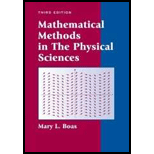
Show in two ways that
Want to see the full answer?
Check out a sample textbook solution
Chapter 12 Solutions
Mathematical Methods in the Physical Sciences
Additional Math Textbook Solutions
Excursions in Modern Mathematics (9th Edition)
Using & Understanding Mathematics: A Quantitative Reasoning Approach (7th Edition)
Using and Understanding Mathematics: A Quantitative Reasoning Approach (6th Edition)
Mathematics with Applications In the Management, Natural, and Social Sciences (12th Edition)
Introductory Mathematics for Engineering Applications
Mathematics with Applications In the Management, Natural and Social Sciences (11th Edition)
- Algebra & Trigonometry with Analytic GeometryAlgebraISBN:9781133382119Author:SwokowskiPublisher:Cengage
 Algebra for College StudentsAlgebraISBN:9781285195780Author:Jerome E. Kaufmann, Karen L. SchwittersPublisher:Cengage Learning
Algebra for College StudentsAlgebraISBN:9781285195780Author:Jerome E. Kaufmann, Karen L. SchwittersPublisher:Cengage Learning Trigonometry (MindTap Course List)TrigonometryISBN:9781337278461Author:Ron LarsonPublisher:Cengage Learning
Trigonometry (MindTap Course List)TrigonometryISBN:9781337278461Author:Ron LarsonPublisher:Cengage Learning


